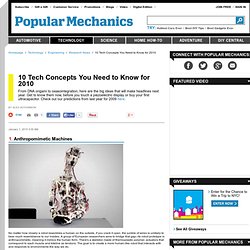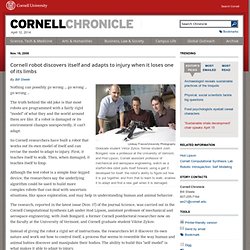

10 Tech Concepts You Need to Know for 2010. 1.

Anthropomimetic Machines No matter how closely a robot resembles a human on the outside, if you crack it open, the jumble of wires is unlikely to bear much resemblance to our insides. A group of European researchers aims to bridge that gap--its robot prototype is anthropomimetic, meaning it mimics the human form. There's a skeleton made of thermoplastic polymer, actuators that correspond to each muscle and kiteline as tendons. The goal is to create a more human-like robot that interacts with and responds to environments the way we do. 2. Yesterday's fuel cells, like those seen here on Spacelab, require a hydrogen infrastructure. Coal is dirty, and fuel cells run on hydrogen--that's the conventional wisdom. 3. 4. Scientists at Caltech have been folding microscopic strands of DNA into interesting shapes for the past few years. 5. (Illustration by Leandro Castelao) 6. (Photograph by Associated Press) The ideal prosthetic limb would behave like part of the natural body. 7.
Cells have many ways to live, only a couple of ways to die. Robert Horvitz's Nobel Prize came largely for his work in turning a small, transparent worm that lives in the dirt into an experimental system that has won several others Nobel Prizes since.

But his pioneering use of C. elegans came about because he was interested in a problem that was simply easier to address in the animal: how and when cells in an organism choose to die through a process called apoptosis. It was his research in this field that was the focus of his talk at the Lindau Nobel Laureates Meeting. You might not be aware of it, but many of an animal's cells kill themselves for the greater good of the organism they're part of.
In adults, cells with a viral infection or extensive DNA damage (or immune cells that react to the body itself) are induced to commit an organized suicide, slicing up their DNA into short fragments and packaging up their membranes and proteins for easy digestion by their neighbors. Identify the victimKillGet rid of the corpseDestroy the evidence.
Robot adapts to injury. Lindsay France/University Photography Graduate student Viktor Zykov, former student Josh Bongard, now a professor at the University of Vermont, and Hod Lipson, Cornell assistant professor of mechanical and aerospace engineering, watch as a starfish-like robot pulls itself forward, using a gait it developed for itself. the robot's ability to figure out how it is put together, and from that to learn to walk, enables it to adapt and find a new gait when it is damaged.

Nothing can possibly go wrong ... go wrong ... go wrong ... The truth behind the old joke is that most robots are programmed with a fairly rigid "model" of what they and the world around them are like. If a robot is damaged or its environment changes unexpectedly, it can't adapt. So Cornell researchers have built a robot that works out its own model of itself and can revise the model to adapt to injury. "Most robots have a fixed model laboriously designed by human engineers," Lipson explained.